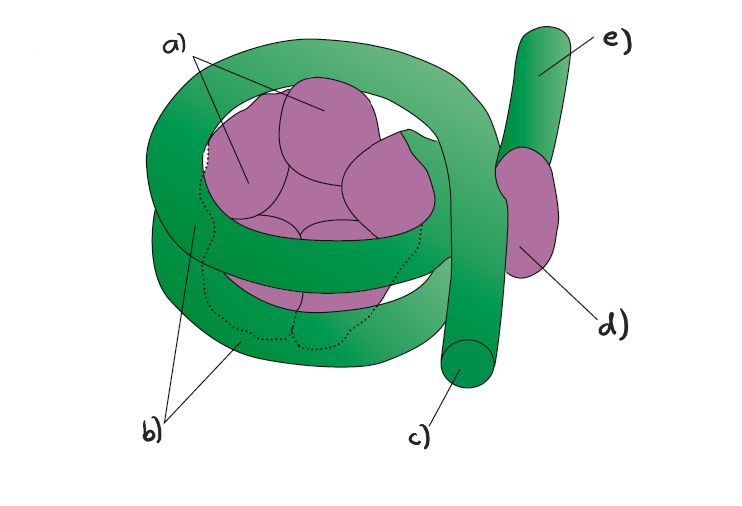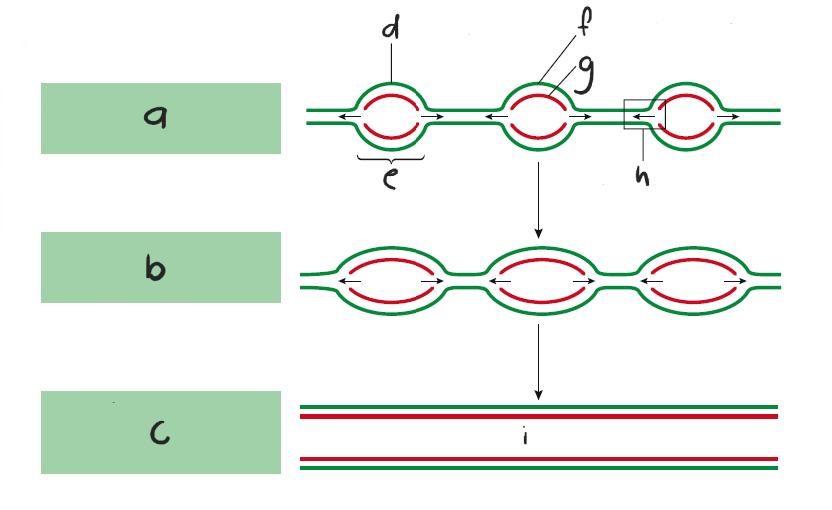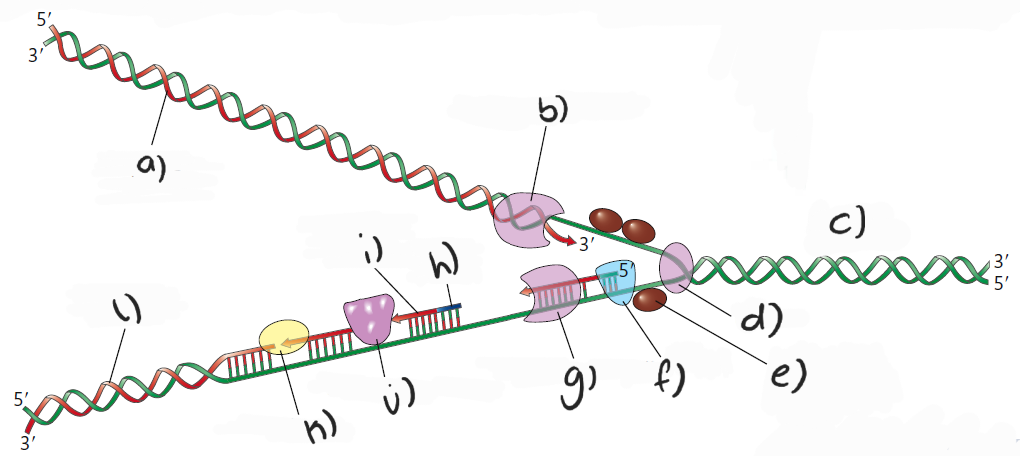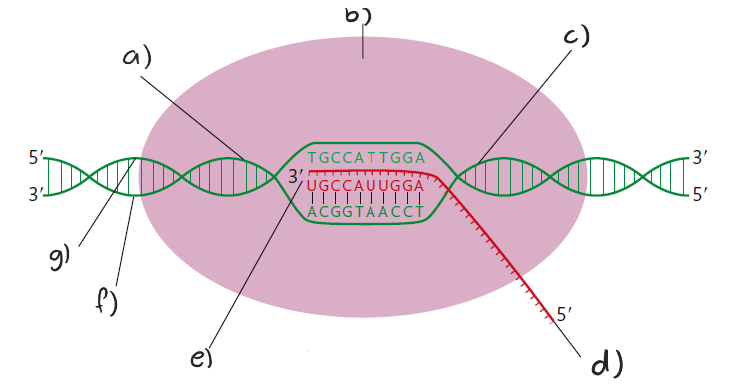Topic 7: Nucleic Acids (copy)
1/169
Earn XP
Description and Tags
7.1: DNA Structure and replication; 7.2: Transcription and gene expression; 7.3: Translation
Name | Mastery | Learn | Test | Matching | Spaced | Call with Kai |
|---|
No study sessions yet.
170 Terms
What is DNA?
DNA is a double stranded molecule formed in the shape of a double helix
What is each strand of DNA composed of?
A backbone of alternating phosphate and deoxyribose molecules
How are phosphate and deoxyribose molecules held together?
By a covalent bond called a phosphodiester bond or linkage
How is a phosphodiester bond formed?
It forms between a hydroxyl group of the 3’ carbon of deoxyribose and the phosphate group attached to the 5’ carbon of deoxyribose
What kind of reaction is the one between the phosphate group on the 5’ carbon and the hydroxyl group on the 3’ carbon
A condensation reaction, with a molecule of water released
When a new nucleotide is added, where is it attached to?
To the 3’ carbon end
What carries the genetic code in DNA?
The sequence of nitrogenous bases
How are the two sugar-phosphate backbones attached to each other?
By their nitrogenous bases
What do we mean when we say the two backbones or chains are antiparallel?
That they run in opposite directions; one strand has the 5’ carbon on the top and the 3’ carbon on the bottom, the other strand is the opposite way round
How do the nitrogenous bases form links?
By hydrogen bonds
Which are the four nitrogenous bases in DNA?
Adenine (A), thymine (T), cytosine (C), and guanine (G)
Which of the four nitrogenous bases are purines (double-ringed)?
Adenine and guanine
Which of the four nitrogenous bases are pyrimidines (single-ringed)?
Cytosine and thymine
In what order do the nitrogenous bases bond with each other?
Adenine always pairs with thymine and guanine always pairs with cytosine
How many hydrogen bonds link adenine and thymine together?
Two hydrogen bonds
How many hydrogen bonds link guanine and cytosine?
Three hydrogen bonds
What does histone help with?
With DNA packaging
Why is the packaging of DNA essential?
Because the nucleus is microscopic and a single human molecule of DNA in a chromosome may be 4cm long

Label the following diagram
a) eight histones, making up the nucleosome core
b) DNA wrapping twice around the histones
c) linker DNA
d) histone 1, which helps maintain the nucleosome
e) linker DNA
What does a nucleosome consist of?
Two molecules of each of four different histones
Why is DNA attracted to the histones?
Because DNA is negatively charged and histones are positively charged
Why is DNA inaccessible to transcription enzymes?
Because DNA is wrapped around the histones and then further wrapped in more elaborate structures
What does the wrapping or packaging of DNA imply in regards to the transcription process?
It regulates it, allowing only certain areas of the DNA molecule to be involved in protein synthesis
What are genomes?
Complete DNA sequencesH
How many repetitive sequences can there be in DNA?
Up to 100,000 replicates
How are repetitive sequences referred to if they’re clustered in discrete areas?
Satellite DNA
____ provide the base sequences essential to produce proteins at the cell ribosomes
Genes that have coding functions
How are base sequences carried from the nucleus to the ribosomes?
By mRNA
What are exons?
The coding fragments of the DNA
What are introns?
The non-coding fragments of the DNA
What is structural DNA?
Highly coiled DNA that does not have a coiling function
Where does structural DNA occur?
Around the centromere and near the ends of chromosomes at the telomers
How are these sections of DNA without a coding function referred as?
Pseudogenes
What is DNA profilling?
It’s the process of obtaining a specific DNA pattern from the body tissue of an organism
What are polymorphisms?
Specific regions in our DNA that show significant variation from other people’s DNA
What are short tandem repeats (STRs)?
They are short, repeating sequences of DNA, normally composed of 2-5 base pairs
What is the semi-conservative model of DNA replication?
The idea that a single strand of DNA could serve as a template for a copy, which would facilitate the accuracy necessary to pass on the DNA information from one generation to the next
Where does DNA replication begin?
At special sites called origins of replication
Briefly outline the replication process
Replication begins at the origin (appears as a bubble thanks to the separation of the strands). The separation (unzipping) occurs thanks to the enzyme helicase acting on the hydrogen bonds between nucleotides
At the end of each bubble is a replication fork, where double stranded DNA opens to provide the two parent DNA strands that are a template to produce the daughter DNA molecules
The bubbles enlarge in both directions, fusing with one another to produce two identical daughter DNA molecules

Label the following diagram
a) Replication begins at a bubble opened by helicase
b) Bubbles expand in both directions
c) Replication bubbles fuse creating two complete DNA strands
d) origin of replication
e) bubble
f) parental (template) strand
g) daughter (new) strand
h) replication fork
i) two daughter DNA molecules
A primer is produced at the direction of _____ at the replication fork
Primase
What is a primer?
A short sequence of RNA, usually 5-10 nucleotides long
What is primase for?
It allows the joining of RNA nucleotides that match the exposed DNA bases at the point of replication
What does the enzyme DNA polymerase III do?
It allows the addition of nucleotides in a 5’ to 3’ direction to produce the growing DNA strand
What does DNA polymerase I do?
It removes the primer from the 5’ end and replaces it with DNA nucleotides
Each nucleotide that is added to the elongating DNA is actually a _____
deoxy nucleoside triphosphate (dNTP) molecule
As these molecules are added, ____ are lost
two phosphate
Why are DNA strands only assembled in the 5’ to 3’ direction?
Because of polymerase III
How is the 3’ to 5’ template strand called and why?
It’s called the leading strand because the process is continuous and relatively fastH
How is the 5’ to 3’ template strand called and why?
It’s called the lagging strand because it forms more slowly
What does the formation of the lagging strand involve?
It involves fragments and an additional enzyme called DNA ligase
How is the leading strand assembled?
It’s assembled continuously towards the progressing replication fork in the 3’ to 5’ direction
How is the lagging strand assembled?
It’s assembled by fragments being produced moving away from the progressing replication fork in the 5’ to 3’ direction
How are the fragments of the lagging strand called?
Okazaki fragments
These are required to begin the formation of each Okazaki fragment
Primer, primase, and DNA polymerase III
How many times are the primer and primase needed in the leading strand?
Only once because the leading strand is produced continuously
What does DNA ligase do?
It attaches the sugar-phosphate backbones of the lagging strand fragments to form a single DNA strand

Label the following diagram
a) leading strand
b) DNA polymerase III
c) parental DNA helix
d) helicase
e) single-strand binding protein
f) primase
g) DNA polymerase III
h) RNA primer
i) Okazaki fragment
j) DNA polymerase I
k) DNA ligase
l) lagging strand
What is the only difference between prokaryotic and eukaryotic replication?
In eukaryotic cells, the enzyme DNA gyrase stabilizes the DNA double helix when helicase unzips the molecule at multiple sites
Around how many nucleotides are replicated per second?
Up to 4,000 nucleotides
What carries DNA from the nucleus to the cytoplasm?
Ribonucleic acid (RNA)
What is the central dogma?
The idea that information passes from genes on the DNA to the RNA copy, which then directs the production of proteins at the ribosome by controlling the sequence of amino acids
Which part of the central dogma process is transcription?
When information passes from the genes on the DNA to the RNA copy
Which part of the central dogma process is translation?
When the RNA copy directs the production of proteins at the ribosome by controlling the sequence of amino acids
What is similar between replication and transcription?
For both processes, the helix must be opened to expose the base sequence of the nucleotides
What is the difference between replication and transcription?
Helicase isn’t involved in transcription
Which is the enzyme in transcription that separates the two DNA strands?
RNA polymerase
What does RNA polymerase do?
Allows polymerization of RNA nucleotides as base pairing occurs along the DNA template
What must happen first before RNA polymerase does its functions?
It must first combine with a region of the DNA strand called a promoter
In what direction does RNA polymerase assemble RNA nucleotides?
It allows assembling only in the 5’ to 3’ direction
What is a codon?
A sequence of three nucleotides which together form a unit of genetic code in a DNA or RNA molecule
How many types of codons are there?
They can be specific for certain amino acids or are start or stop messages
How are the start or stop codons known as?
Punctuation signals
What is the sense strand?
It’s the DNA strand that carries the genetic code for a certain protein (also called the coding strand) and it has the same sequence as the newly transcribed RNA, except with thymine instead of uracil
What is the antisense strand?
Also called the template strand, it’s the strand that is copied during transcription
The _____ for a particular gene determines which DNA strand is the antisense strand
Promoter region
When does the transcription process start?
Once RNA polymerase has attached to the promoter region for a particular gene
What happens after RNA polymerase has attached to the promoter region?
The DNA opens and a transcription bubble forms, which contains the antisense DNA strand, the RNA polymerase and the RNA transcript

Label the following diagram
a) the front of RNA polymerase opens the DNA helix
b) RNA polymerase
c) the back of RNA polymerase rewinds the DNA strands
d) mRNA molecule
e) RNA polymerase adds nucleoside triphosphates to the enlarging mRNA molecule, releasing two phosphates
f) antisense strand
g) sense strand
Which are the DNA sections involved in transcription?
Promoter → transcription unit → terminator
The (a) moves from the DNA (b) region towards the (c)
a) transcription bubble
b) promoter
c) terminator
What is the terminator?
It’s a sequence of nucleotides that, when transcribed, causes the RNA polymerase to detach from the DNA, stopping transcription
In eukaryotes, transcription continues…
beyond the terminator for a significant number of nucleotides; eventually the transcript is released from the DNA strand
What is a nucleoside triphosphate?
It’s paired with the appropriate exposed bases for the antisense strand, for the purpose of releasing two phosphates to provide energy for the polymerization of the mRNA strand
What is nucleoside triphosphate composed of?
Three phosphates and the 5-carbon sugar ribose
How does the polymerization of the mRNA strand (elongation) occur?
With the catalytic help of RNA polymerase and the energy provided by the release of two phosphates from NTP
Which is the first RNA formed in DNA transcription?
Pre-mRNA or the primary RNA transcript
What does pre-mRNA contain?
Both exons and introns
How do we make a functional mRNA strand in eukaryotes?
The introns are removed?
What is splicing?
The process by which the introns are removed
During splicing, a (a) and a (b) are added to the ends of what is now called mature mRNA
a) cap
b) poly-A tail
What are spliceosomes?
They’re composed of small nuclear RNAs (snRNAs); they remove the introns
What can we find at the 5’ end of the mature mRNA transcript?
A cap made of a modified guanine nucleotide with three phosphates
What can we find at the 3’ end of the mature mRNA transcript?
A poly-A tail, which is composed of 50-250 adenine nucleotides
What is the purpose of the cap and the poly-A tail?
To protect the mature mRNA from degradation in the cytoplasm and to enhance the translation process that occurs at the ribosome
What is a methyl group?
It’s an organic functional group with the formula CH₃
What happens with the genes that are heavily methylated?
They’re not usually transcribed or expressed, and it usually stays that way even through many cell divisions
What are transcript activators?
They’re proteins that cause the looping of the DNA, which results in a shorter distance between the activator and the promoter region of the gene, bringing about gene expression
What are silencers?
They’re proteins that bind to segments of DNA and prevent transcription of the segment of that particular region
When does the translation process begin?
Once mRNA is produced from the DNA template